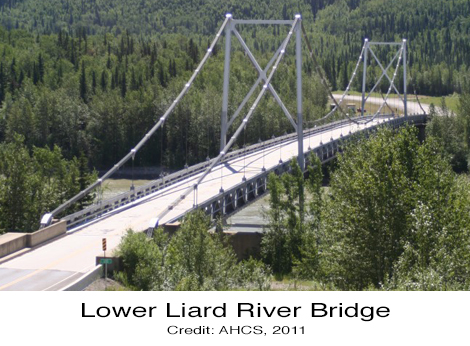Lower Liard River Bridge
Approaching kilometre 256.1 on the Alaska Highway, motorists are often amazed by the sight of the 24.65 m (94 feet) tall Lower Liard River Bridge looming over the isolated northern British Columbia landscape. Imposing and gracefully symmetrical, the bridge has become a popular postcard and photographic subject.
Built in 1943, the 307 m long steel bridge is one of the six “special crossings” on the Alaska Highway, and the only suspension bridge on the route (the other suspension bridge, which spanned the Peace River, collapsed in 1957). The US Public Roads Administration (PRA) engineers decided that a suspension bridge had to be built at this point because ice conditions made it impossible to keep the necessary temporary scaffolding in place long enough to build the PRA’s usual type of bridge – a standardized truss span design.
The Lower Liard River Bridge is also unique because much of the materials used to build it came from steel salvaged from the historic Tacoma Narrows Bridge. (This bridge became famous when it collapsed in 1940 due to faulty engineering that fatally intensified the bridge’s normal sway.) Using salvaged material for steel structures was common during wartime as a way to overcome shortages and reduce costs.
Out of the 25 bridges maintained on the Canadian section of the Alaska Highway, the Lower Liard River Bridge is a widely recognized landmark in an already historic cultural landscape through which Indigenous peoples, fur traders and geological survey explorers had long ago travelled.

